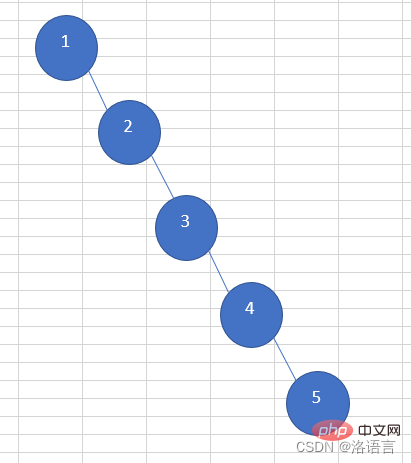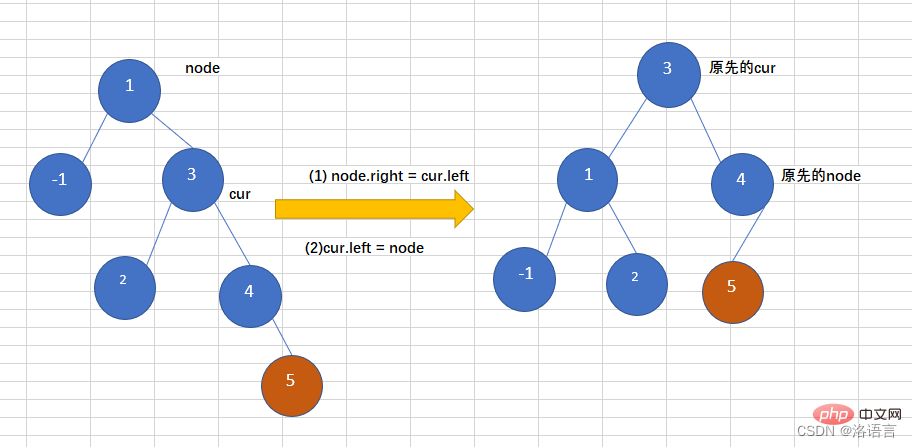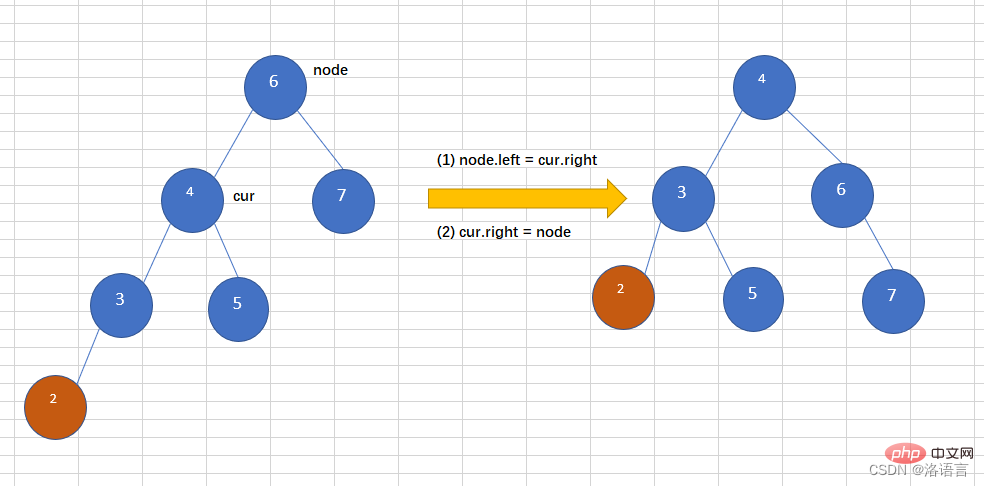Detailed explanation of AVL tree of Java data structure
This article brings you relevant knowledge about java, which mainly introduces the relevant knowledge about balanced binary trees (AVL trees). AVL trees are essentially binary trees with balancing functions. Find the tree, let’s take a look at it, I hope it will be helpful to everyone.

Recommended study: "java video tutorial"
Introduction of AVL tree
Searching binary trees has extremely high The search efficiency is high, but the following extreme situations will occur when searching a binary tree: 
The search efficiency of such a binary tree is even lower than that of a linked list. The balanced binary tree (AVL tree) that appears based on the search binary tree solves this problem. When the absolute value of the height difference between the left and right subtrees of a node in a balanced binary tree (AVL tree) is greater than 1, their height difference will be reduced through a rotation operation.
Basic concept
The AVL tree is essentially a binary search tree. Its characteristics are:
- itself is first a
binary search tree. Search tree. - The absolute value (balance factor) of the difference between the
heights of the left and right subtrees of each node is at most 1. In other words, the AVL tree is essentially a binary search tree (binary sorting tree, binary search tree) withbalancing function. - When inserting a node or deleting a node, the absolute value of the height difference between the left and right subtrees of a node is greater than 1. In this case,
left rotationandright rotation# are required. ##The operation makes the binary tree reach a balanced state again.
Balance Factor (balanceFactor)
- The difference in height between the left subtree and the right subtree of a node
- .
The BF of any node in the AVL tree can only be-1, 0 and 1.
The following are the simple methods and attributes required by the AVL tree:
public class AVLTree <e>>{
class Node{
E value;
Node left;
Node right;
int height;
public Node(){}
public Node(E value){
this.value = value;
height = 1;
left = null;
right = null;
}
public void display(){
System.out.print(this.value + " ");
}
}
Node root;
int size;
public int size(){
return size;
}
public int getHeight(Node node) {
if(node == null) return 0;
return node.height;
}
//获取平衡因子(左右子树的高度差,大小为1或者0是平衡的,大小大于1不平衡)
public int getBalanceFactor(){
return getBalanceFactor(root);
}
public int getBalanceFactor(Node node){
if(node == null) return 0;
return getHeight(node.left) - getHeight(node.right);
}
//判断一个树是否是一个平衡二叉树
public boolean isBalance(Node node){
if(node == null) return true;
int balanceFactor = Math.abs(getBalanceFactor(node.left) - getBalanceFactor(node.right));
if(balanceFactor > 1) return false;
return isBalance(node.left) && isBalance(node.right);
}
public boolean isBalance(){
return isBalance(root);
}
//中序遍历树
private void inPrevOrder(Node root){
if(root == null) return;
inPrevOrder(root.left);
root.display();
inPrevOrder(root.right);
}
public void inPrevOrder(){
System.out.print("中序遍历:");
inPrevOrder(root);
}}</e>RR (Left-handed)
Go to one Inserting a node into the right subtree of the right subtree of the tree causes the binary tree to become unbalanced, as shown in the figure below. Inserting 5 into the balanced binary tree causes the tree to become unbalanced. At this time, a left-turn operation is required, as follows:
The code is as follows: 
//左旋,并且返回新的根节点
public Node leftRotate(Node node){
System.out.println("leftRotate");
Node cur = node.right;
node.right = cur.left;
cur.left = node;
//跟新node和cur的高度
node.height = Math.max(getHeight(node.left),getHeight(node.right)) + 1;
cur.height = Math.max(getHeight(cur.left),getHeight(cur.right)) + 1;
return cur;
}LL (right rotation)
Insert a node into the left subtree of the left subtree of an AVL tree, causing the binary tree to become unbalanced. As shown in the figure below, inserting 2 into the balanced binary tree causes the tree to become unbalanced. At this time, a left-turn operation is required, as follows:
The code is as follows: 
//右旋,并且返回新的根节点
public Node rightRotate(Node node){
System.out.println("rightRotate");
Node cur = node.left;
node.left = cur.right;
cur.right = node;
//跟新node和cur的高度
node.height = Math.max(getHeight(node.left),getHeight(node.right)) + 1;
cur.height = Math.max(getHeight(cur.left),getHeight(cur.right)) + 1;
return cur;
}LR (left-turn first Then rotate right)
Insert a node into the right subtree
of the AVL treeleft subtree, causing the tree to no longer be balanced. You need to perform a left rotation on the left subtree# first. ##, then right-turn the entire tree , as shown in the figure below, insert node 5.
RL (first right-turn and then left-turn)
of the AVL tree
right subtree, causing the tree to become unbalanced. You need to right-rotate theright subtree first, and then The whole tree is left-handed, as shown in the figure below, the inserted node is 2.
Add node
//添加元素
public void add(E e){
root = add(root,e);
}
public Node add(Node node, E value) {
if (node == null) {
size++;
return new Node(value);
}
if (value.compareTo(node.value) > 0) {
node.right = add(node.right, value);
} else if (value.compareTo(node.value) 1 && getBalanceFactor(node.left) >= 0) {
return rightRotate(node);
}
//该子树不平衡且新插入节点(导致不平衡的节点)在右子树子树的右子树上,此时需要进行左旋
else if (balanceFactor 1 && getBalanceFactor(node.left) 0
//该子树不平衡且新插入节点(导致不平衡的节点)在右子树的左子树上,此时需要先对右子树右旋,再整个树左旋
else if(balanceFactor 0) {
node.right = rightRotate(node.right);
return leftRotate(node);
}
return node;
} //删除节点
public E remove(E value){
root = remove(root,value);
if(root == null){
return null;
}
return root.value;
}
public Node remove(Node node, E value){
Node retNode = null;
if(node == null)
return retNode;
if(value.compareTo(node.value) > 0){
node.right = remove(node.right,value);
retNode = node;
}
else if(value.compareTo(node.value) 1 && getBalanceFactor(retNode.left) >= 0) {
return rightRotate(retNode);
}
//该子树不平衡且新插入节点(导致不平衡的节点)在右子树子树的右子树上,此时需要进行左旋
else if (balanceFactor 1 && getBalanceFactor(retNode.left) 0) {
retNode.right = rightRotate(retNode.right);
return leftRotate(retNode);
}
return retNode;
}Copy after login
Recommended study: " //删除节点
public E remove(E value){
root = remove(root,value);
if(root == null){
return null;
}
return root.value;
}
public Node remove(Node node, E value){
Node retNode = null;
if(node == null)
return retNode;
if(value.compareTo(node.value) > 0){
node.right = remove(node.right,value);
retNode = node;
}
else if(value.compareTo(node.value) 1 && getBalanceFactor(retNode.left) >= 0) {
return rightRotate(retNode);
}
//该子树不平衡且新插入节点(导致不平衡的节点)在右子树子树的右子树上,此时需要进行左旋
else if (balanceFactor 1 && getBalanceFactor(retNode.left) 0) {
retNode.right = rightRotate(retNode.right);
return leftRotate(retNode);
}
return retNode;
}java video tutorial
"The above is the detailed content of Detailed explanation of AVL tree of Java data structure. For more information, please follow other related articles on the PHP Chinese website!

Hot AI Tools

Undresser.AI Undress
AI-powered app for creating realistic nude photos

AI Clothes Remover
Online AI tool for removing clothes from photos.

Undress AI Tool
Undress images for free

Clothoff.io
AI clothes remover

Video Face Swap
Swap faces in any video effortlessly with our completely free AI face swap tool!

Hot Article

Hot Tools

Notepad++7.3.1
Easy-to-use and free code editor

SublimeText3 Chinese version
Chinese version, very easy to use

Zend Studio 13.0.1
Powerful PHP integrated development environment

Dreamweaver CS6
Visual web development tools

SublimeText3 Mac version
God-level code editing software (SublimeText3)

Hot Topics
 Break or return from Java 8 stream forEach?
Feb 07, 2025 pm 12:09 PM
Break or return from Java 8 stream forEach?
Feb 07, 2025 pm 12:09 PM
Java 8 introduces the Stream API, providing a powerful and expressive way to process data collections. However, a common question when using Stream is: How to break or return from a forEach operation? Traditional loops allow for early interruption or return, but Stream's forEach method does not directly support this method. This article will explain the reasons and explore alternative methods for implementing premature termination in Stream processing systems. Further reading: Java Stream API improvements Understand Stream forEach The forEach method is a terminal operation that performs one operation on each element in the Stream. Its design intention is
 PHP: A Key Language for Web Development
Apr 13, 2025 am 12:08 AM
PHP: A Key Language for Web Development
Apr 13, 2025 am 12:08 AM
PHP is a scripting language widely used on the server side, especially suitable for web development. 1.PHP can embed HTML, process HTTP requests and responses, and supports a variety of databases. 2.PHP is used to generate dynamic web content, process form data, access databases, etc., with strong community support and open source resources. 3. PHP is an interpreted language, and the execution process includes lexical analysis, grammatical analysis, compilation and execution. 4.PHP can be combined with MySQL for advanced applications such as user registration systems. 5. When debugging PHP, you can use functions such as error_reporting() and var_dump(). 6. Optimize PHP code to use caching mechanisms, optimize database queries and use built-in functions. 7
 PHP vs. Python: Understanding the Differences
Apr 11, 2025 am 12:15 AM
PHP vs. Python: Understanding the Differences
Apr 11, 2025 am 12:15 AM
PHP and Python each have their own advantages, and the choice should be based on project requirements. 1.PHP is suitable for web development, with simple syntax and high execution efficiency. 2. Python is suitable for data science and machine learning, with concise syntax and rich libraries.
 PHP vs. Other Languages: A Comparison
Apr 13, 2025 am 12:19 AM
PHP vs. Other Languages: A Comparison
Apr 13, 2025 am 12:19 AM
PHP is suitable for web development, especially in rapid development and processing dynamic content, but is not good at data science and enterprise-level applications. Compared with Python, PHP has more advantages in web development, but is not as good as Python in the field of data science; compared with Java, PHP performs worse in enterprise-level applications, but is more flexible in web development; compared with JavaScript, PHP is more concise in back-end development, but is not as good as JavaScript in front-end development.
 Java Program to Find the Volume of Capsule
Feb 07, 2025 am 11:37 AM
Java Program to Find the Volume of Capsule
Feb 07, 2025 am 11:37 AM
Capsules are three-dimensional geometric figures, composed of a cylinder and a hemisphere at both ends. The volume of the capsule can be calculated by adding the volume of the cylinder and the volume of the hemisphere at both ends. This tutorial will discuss how to calculate the volume of a given capsule in Java using different methods. Capsule volume formula The formula for capsule volume is as follows: Capsule volume = Cylindrical volume Volume Two hemisphere volume in, r: The radius of the hemisphere. h: The height of the cylinder (excluding the hemisphere). Example 1 enter Radius = 5 units Height = 10 units Output Volume = 1570.8 cubic units explain Calculate volume using formula: Volume = π × r2 × h (4
 PHP vs. Python: Core Features and Functionality
Apr 13, 2025 am 12:16 AM
PHP vs. Python: Core Features and Functionality
Apr 13, 2025 am 12:16 AM
PHP and Python each have their own advantages and are suitable for different scenarios. 1.PHP is suitable for web development and provides built-in web servers and rich function libraries. 2. Python is suitable for data science and machine learning, with concise syntax and a powerful standard library. When choosing, it should be decided based on project requirements.
 Create the Future: Java Programming for Absolute Beginners
Oct 13, 2024 pm 01:32 PM
Create the Future: Java Programming for Absolute Beginners
Oct 13, 2024 pm 01:32 PM
Java is a popular programming language that can be learned by both beginners and experienced developers. This tutorial starts with basic concepts and progresses through advanced topics. After installing the Java Development Kit, you can practice programming by creating a simple "Hello, World!" program. After you understand the code, use the command prompt to compile and run the program, and "Hello, World!" will be output on the console. Learning Java starts your programming journey, and as your mastery deepens, you can create more complex applications.
 PHP: The Foundation of Many Websites
Apr 13, 2025 am 12:07 AM
PHP: The Foundation of Many Websites
Apr 13, 2025 am 12:07 AM
The reasons why PHP is the preferred technology stack for many websites include its ease of use, strong community support, and widespread use. 1) Easy to learn and use, suitable for beginners. 2) Have a huge developer community and rich resources. 3) Widely used in WordPress, Drupal and other platforms. 4) Integrate tightly with web servers to simplify development deployment.






